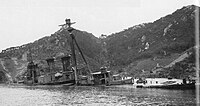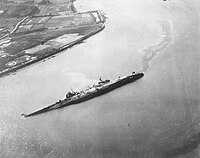
The Battle of Leyte Gulf was the largest naval battle of World War II and by some criteria the largest naval battle in history, with over 200,000 naval personnel involved. It was fought in waters near the Philippine islands of Leyte, Samar, and Luzon from 23 to 26 October 1944 between combined American and Australian forces and the Imperial Japanese Navy (IJN), as part of the invasion of Leyte, which aimed to isolate Japan from the colonies that it had occupied in Southeast Asia, a vital source of industrial and oil supplies.

Yamato (大和) was the lead ship of her class of battleships built for the Imperial Japanese Navy (IJN) shortly before World War II. She and her sister ship, Musashi, were the heaviest and most powerfully armed battleships ever constructed, displacing nearly 72,000 tonnes at full load and armed with nine 46 cm (18.1 in) Type 94 main guns, which were the largest guns ever mounted on a warship.

Haruna (榛名) was a warship of the Imperial Japanese Navy during World War I and World War II. Designed by the British naval engineer George Thurston and named after Mount Haruna, she was the fourth and last battlecruiser of the Kongō class, amongst the most heavily armed ships in any navy when built. Laid down in 1912 at the Kawasaki Shipyards in Kobe, Haruna was formally commissioned in 1915 on the same day as her sister ship, Kirishima. Haruna patrolled off the Chinese coast during World War I. During gunnery drills in 1920, an explosion destroyed one of her guns, damaged the gun turret, and killed seven men.

The Battle off Samar was the centermost action of the Battle of Leyte Gulf, one of the largest naval battles in history, which took place in the Philippine Sea off Samar Island, in the Philippines on October 25, 1944. It was the only major action in the larger battle in which the Americans were largely unprepared. After the previous day's fighting, the Imperial Japanese Navy's First Mobile Striking Force, under the command of Takeo Kurita, had suffered significant damages and appeared to be retreating westward. However, by the next morning, the Japanese force had turned around and resumed its advance toward Leyte Gulf. With Admiral William Halsey Jr. lured into taking his powerful Third Fleet north after a decoy fleet and the Seventh Fleet engaged to the south, the recently-landed 130,000 men of the Sixth Army were left vulnerable to Japanese attack on Leyte.

Chikuma (筑摩) was the second and last vessel in the Tone class of heavy cruisers in the Imperial Japanese Navy. The ship was named after the Chikuma River in Nagano Prefecture. Entering service in 1939, Chikuma saw battle during World War II in the Pacific, hunting small allied ships in the Indian Ocean and serving in many escorting missions throughout many large-scale aircraft carrier battles between Japan and the United States. On the 25 of October 1944, she served in the Battle off Samar where she possibly sank the escort carrier USS Gambier Bay and damaged the destroyer USS Heermann, before being crippled by gunfire from the destroyer escort USS Samuel B. Roberts and sunk by air attacks.

Ise was the lead ship of her class of two dreadnought battleships built for the Imperial Japanese Navy (IJN) during the 1910s. Although completed in 1917, she played no role in World War I. Ise supported Japanese forces in the early 1920s during the Siberian Intervention in the Russian Civil War. In 1923, she assisted survivors of the Great Kantō earthquake. The ship was partially modernised in two stages in 1928–1929 and 1931–1932, during which her forward superstructure was rebuilt in the pagoda mast style. Ise was reconstructed in 1934–1937, with improvements to her armour and her propulsion machinery. Afterwards she played a minor role in the Second Sino-Japanese War.

Kirishima (霧島) was a warship of the Imperial Japanese Navy which saw service during World War I and World War II. Designed by British naval engineer George Thurston, she was the third launched of the four Kongō-class battlecruisers. Laid down in 1912 at the Mitsubishi Shipyards in Nagasaki, Kirishima was formally commissioned in 1915 on the same day as her sister ship, Haruna. Kirishima patrolled on occasion off the Chinese coast during World War I, and helped with rescue efforts following the 1923 Great Kantō earthquake.

Tone (利根) was the lead ship in the two-vessel Tone class of heavy cruisers in the Imperial Japanese Navy. The ship was named after the Tone River, in the Kantō region of Japan and was completed on 20 November 1938 at Mitsubishi's Nagasaki shipyards. Tone was designed for long-range scouting missions and had a large seaplane capacity. She was extensively employed during World War II usually providing scouting services to their aircraft carrier task forces. She almost always operated in this capacity in conjunction with her sister ship Chikuma.
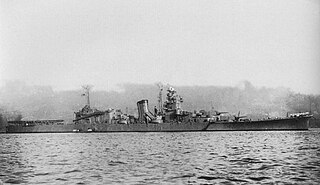
Ōyodo (大淀) was a light cruiser built for the Imperial Japanese Navy (IJN) during World War II, and was the only ship of her class completed before the end of the war. Designed to command submarine operations, she was obsolete upon completion in 1943. The ship was used as a transport and to escort the navy's capital ships for the rest of the year. Ōyodo was lightly damaged by American aircraft in early January 1944 during one transport mission and returned home several months later to begin conversion to serve as the flagship of the Combined Fleet.

Yahagi (矢矧) was an Agano-class cruiser which served with the Imperial Japanese Navy (IJN) during World War II.

Kumano (熊野) was one of four Mogami class of heavy cruisers in the Imperial Japanese Navy, serving in World War II. She was named after the Kumano River Kii Peninsula on the island of Honshu in central Japan. The Mogami-class ships were constructed as "light cruisers" with five triple 6.1-inch dual purpose guns. They were exceptionally large for light cruisers, and the barbettes for the main battery were designed for quick refitting with twin 8-inch guns. In 1937 all four ships were "converted" to heavy cruisers in this fashion. Kumano served in numerous combat engagements in the Pacific War, until she was eventually sunk by carrier aircraft from Task Force 38 while she was undergoing repairs at Santa Cruz, Zambales, Philippines, in November 1944.

Kinugasa (衣笠) was the second vessel in the two-vessel Aoba class of heavy cruisers in the Imperial Japanese Navy. The ship was named after Mount Kinugasa, located in Yokosuka, Kanagawa, Japan.

Suzutsuki (涼月) was an Akizuki-class destroyer of the Imperial Japanese Navy. Her name means "Clear Moon ". Suzutsuki is best known for her participation in Operation Ten-Go as one of the battleship Yamato's eight escort ships, where her bow was blown off by an American torpedo. Suzutsuki survived the battle, and escaped American forces by reversing all the way back to port. She was used as a breakwater until 20 November 1945, when her name was struck from the naval register and she was sold for scrap soon after. Suzutsuki was the longest serving member of her class.

Kasumi was the ninth of ten Asashio-class destroyers built for the Imperial Japanese Navy in the mid-1930s under the Circle Two Supplementary Naval Expansion Program.
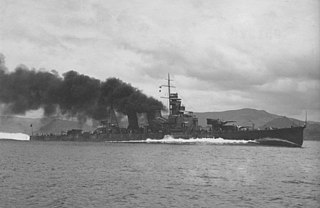
Aoba (青葉) was the lead ship in the two-vessel Aoba class of heavy cruisers in the Imperial Japanese Navy. Launched in 1926 and heavily modernized in 1938-40, Aoba initially served as a patrol craft, largely along the China coast, and saw extensive service during World War II. Repeatedly heavily damaged and repaired, she was finally crippled by bombing and settled on the bottom of shallow Kure harbor in April 1945; two raids in late July reduced her to an unsalvageable hulk. During the attack on 24 July 1945, future Vice admiral Dick H. Guinn dropped the 2,000 lb (910 kg) bomb which contributed to the sinking of that vessel.
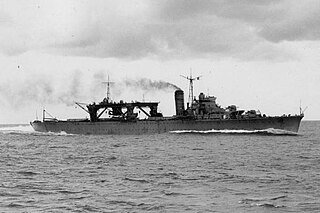
Chiyoda was a light aircraft carrier of the Imperial Japanese Navy during World War II. Originally constructed as the second vessel of the Chitose-class seaplane tenders in 1934, she continued to operate in that capacity during the Second Sino-Japanese War and the early stages of the Pacific War until her conversion into a light aircraft carrier after the Battle of Midway. She was sunk during the Battle of Leyte Gulf by a combination of naval bombers, cruiser shellfire and destroyer-launched torpedoes.

Operation Kita was conducted by the Imperial Japanese Navy (IJN) during the Pacific War in February 1945. Its purpose was to return two Ise-class hybrid battleship-aircraft carriers and four escort ships to Japan from Singapore, where they had been based since November the previous year. The movement of the Japanese force was detected by the Allies, but all attempts to attack it with submarines and aircraft failed. Nevertheless, as a result of the intensifying Allied blockade of Japan, the Ise-class battleship-carriers and their escorts were among the last IJN warships to safely reach the country from the Southwest Pacific before the end of the war.

The attack on Yokosuka was an air raid conducted by the United States Navy on 18 July 1945 during the last weeks of the Pacific War. The Japanese battleship Nagato was the raid's main target, though anti-aircraft positions and other warships at Yokosuka Naval Arsenal were also attacked. Other U.S. Navy and Royal Navy aircraft struck airfields in the Tokyo area.

The attack on Kure was an air raid conducted during the Pacific War by the United States Navy on 19 March 1945. It targeted the remnants of the Japanese Combined Fleet located in and near the Japanese city of Kure. The attack by 321 aircraft was unsuccessful, as no Japanese warships were sunk though several were damaged. Japanese forces struck the American fleet on the morning of 19 March, and crippled one aircraft carrier and badly damaged another.









